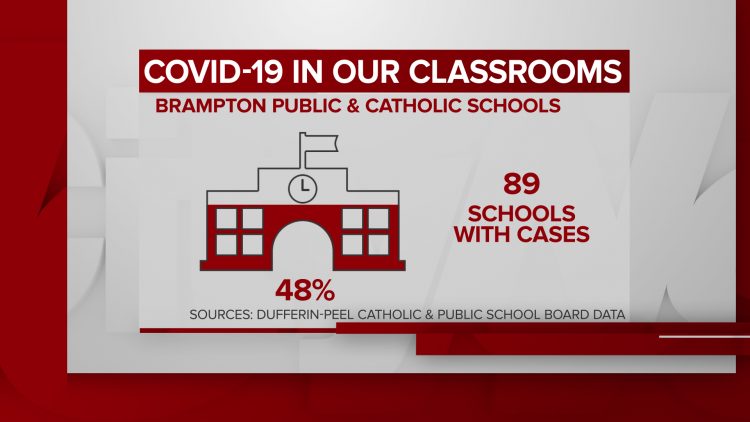
One in three Toronto public schools have an active case of COVID-19 – more than double the provincial average being touted by Ontario’s education minister as he promotes the government’s school safety strategy and the picture worsens at other boards in pandemic hot spots.
Posted Nov 25, 2020, 06:29AM EST
One in three Toronto public schools have an active case of COVID-19 – more than double the provincial average being touted by Ontario’s education minister as he promotes the government’s school safety strategy and the picture worsens at other boards in pandemic hot spots.
In Toronto’s public board, 35 per cent of schools, some 206 facilities, have at least one student or staff member who are reported as actively sick with COVID-19. Of Toronto’s Catholic schools, 40 per cent – or 79 institutions — have active cases. In Brampton, 48 per cent of all schools, both public and Catholic, have active cases.

Toronto and Peel are in lockdown so it’s no surprise they have more cases than the provincial average, but the premier has acknowledged it’s concerning.
“It is definitely setting off alarm bells,” Premier Doug Ford said at a press conference Tuesday.
The government has consistently said it is safer for students to be in school, and that the priority is to keep them open. It has never mentioned that cases in locked-down regions are significantly higher than the provincial average, which is 14.6 percent. Four schools are currently closed due to outbreaks.
Education Minister Stephen Lecce stood in the legislature Monday and insisted schools were safe.
“Parents want the facts. Here’s a fact that I think would instill a level of confidence: if they knew that 99.95% of students are COVID-19-free, that 99.92% of staff are COVID-19-free, that 99.7% of staff have never had COVID-19,” said Lecce. “Our leadership in public health and our school boards are working together to flatten this curve, to reduce the risk and to keep our kids safe, and that is a good thing we should celebrate in this province”
In Brampton, 61 public schools and 28 Catholic schools are reporting 122 and 89 cases, respectively. In the public board, 51 schools beyond Brampton are reporting a further 78 cases. Of those, 46 schools are in Mississauga, four schools are in Caledon, and one is in Bolton.

In the Dufferin-Peel Catholic board, 37 schools outside of Brampton are reporting a total of 61 cases. All but one of those schools is in Mississauga, with the lone other location in Caledon.
Brampton’s percentage of schools with active COVID-19 cases exceeds the proportion in its school boards in large.
The rate across Dufferin-Peel Catholic School Board, which includes Mississauga, Caledon, Bolton and Orangeville, is 43 per cent, with a total 65 of its 151 elementary and secondary schools reporting active cases. In Peel’s public board, which serves Brampton, Mississauga and Caledon, the rate is 44 per cent, or 112 of the boards 257 schools.
CityNews has used the latest information posted on all the boards’ own websites to compile this data.
The premier said today that he was not downplaying cases at schools: “numbers don’t lie, they are out there.”
Ontario’s Chief Medical Officer of Health has said several times it is important to keep schools open for children’s mental health, and while students and staff are bringing COVID-19 into schools, it’s not being spread inside them. Provincial Minister of Health Christine Elliott echoed that today, adding she would re-evaluate the situation if needed.
“If the circumstances change and there’s a huge increase in the number of cases in schools, we might have to take another look at it,” Elliott said.
Ontario has started deploying rapid testing in long-term care homes and rural communities. Ford called it a game-changer and suggested if schools needed testing, it could happen. University of Toronto epidemiologist Colin Furness says he doesn’t believe schools need to close, but he says those inside should be tested regularly.
“We should be doing surveillance testing broadly in the province, we should have been doing that since April. By surveillance testing, I mean you don’t test people who show up at hospital looking sick, that’s diagnostic testing. Surveillance testing means you go and test people at risk,” he explained.
“We should be testing teachers because they are also in high-risk positions, and if want to know what’s going on with COVID in schools, test teachers,” he added, “But Ontario has been very resolutely committed to not doing surveillance testing. We are not trying to control transmission with testing, we are controlling with lockdowns. I think that’s unfortunate.”
